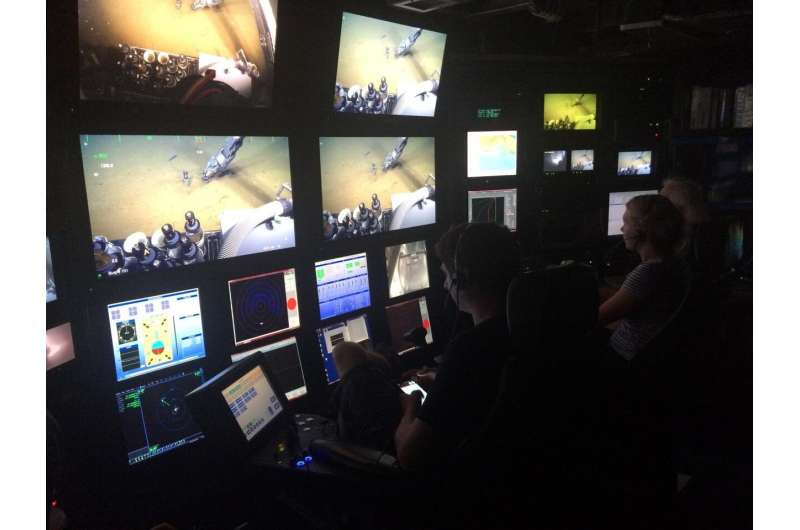Deep-sea fish community structure strongly affected by oxygen and temperature

Understanding the impacts of climate change on fish communities is an important piece of navigating the future, but it's difficult to tease out the individual factors at play in natural systems. This makes it hard for researchers to fully understand how climate change will affect the diversity and abundance of fishes in the future.
In a new study, researchers from Scripps Institution of Oceanography at the University of California San Diego and the Monterey Bay Aquarium Research Institute (MBARI) took advantage of the natural oceanographic gradient in the Gulf of California to study the effects of variable oxygen levels and temperatures on demersal fish communities—fish that live on or near the seafloor. They determined that in regions containing very low levels of oxygen (7 μmol/kg of oxygen or less), fish diversity declined dramatically. For comparison, oxygen concentration at the ocean surface is usually between 200 and 300 μmol/kg. This has implications for the future of deep-sea fish communities in the face of climate change.
In the study, published on March 5 in Marine Ecology Progress Series, the researchers conducted surveys in three different regions in the Gulf of California. The gulf's unique seafloor geography provides dramatically different environmental conditions within a relatively short distance. In the north, deep seawater temperatures are relatively warm with high oxygen levels while in the south, the deep sea is colder and extremely oxygen poor.
"It's really rare to find such large differences across such a small spatial scale," said lead author Natalya Gallo, a marine ecologist and postdoctoral research associate at Scripps Oceanography. "This lets us pick apart some of the environmental factors that affect the types of fish communities we see, making this a really great study system."
Researchers used the remotely operated vehicle (ROV) Doc Ricketts of MBARI to conduct seafloor video transects in the northern, central, and southern Gulf and found a diversity of fish species across the region. Studying the composition, density, and diversity of demersal fish communities alongside the environmental conditions revealed trends that can help inform our understanding of climate change and better prepare for a sustainable future.
In the study, funded by the David and Lucile Packard Foundation and MBARI, the team examined a number of variables, including oxygen level, temperature, depth, habitat type, food input, and latitude, and their relationships to the characteristics of the demersal fish communities.
"We wanted to use these natural gradients to study how environmental variables correlate with community structure, in an effort to understand climate change risk and vulnerabilities," said Gallo. "We found that once the oxygen concentration crosses a certain threshold (7 umol/kg), we see a very strong negative impact on the diversity of species in an area. We also found that oxygen concentration and temperature interact, with higher temperatures linked to reduced fish densities under low oxygen conditions, and to increasing fish densities under better oxygenated conditions."
"The fact that, when including all of these variables in our model, oxygen and temperature came out as the strongest drivers of community structure, really showcases the importance of these two climate-sensitive environmental variables."
However, Gallo was surprised to find that despite these trends in diversity, the team still saw large numbers of fish under low oxygen conditions. "I thought we'd have regions where we saw basically no fish, due to the low oxygen levels," she said. "It was really remarkable to see high density fish communities in areas with basically no oxygen."
This shows that despite the reduced diversity of species in these low-oxygen zones, some species have adaptations that allow them to survive despite hypoxic conditions.
The research team then coupled the results from the community analyses with future climate model projections for the Gulf of California to determine what long-term trends might be expected in these fish communities.
The results showed that if climate change proceeds as expected under the "business as usual" scenario, within the next 80 years, fish communities in the Northern and Central Gulf are likely to be most impacted due to the combined effects of warming and oxygen loss, and existing oceanographic conditions. This could lead to reductions in the habitats of some fish species, making the communities unstable and vulnerable.
"This work helps us understand how trends in oxygen level and temperature are likely to affect fish communities going forward," said Gallo, whose research was supported by a National Science Foundation graduate research fellowship. "We can use these data to understand climate change vulnerability in demersal fish, and similar work in the future will help us better understand the impacts on other kinds of fish species, as well as how and why some fish can survive under such low oxygen conditions."
"This has implications for how we manage deep sea ecosystems as the climate changes," said senior author James Barry, a senior scientist at MBARI. "Right now, we set guidelines for how many fish can be taken by fisheries, based on our understanding of the ecosystem and reproductive rates. But as the ocean is changing, those guidelines might not be sustainable."
"This study, and others like it, tell us what might happen in the future as we drive environmental changes in the ocean," he added. "This allows us to create a framework of understanding so we can make informed decisions about the protection and management of entire ecosystems and the benefits we gain from them."
More information: ND Gallo et al. Dissolved oxygen and temperature best predict deep-sea fish community structure in the Gulf of California with climate change implications, Marine Ecology Progress Series (2020). DOI: 10.3354/meps13240
Journal information: Marine Ecology Progress Series
Provided by University of California - San Diego





















